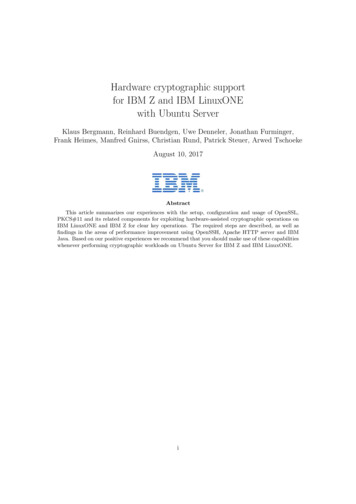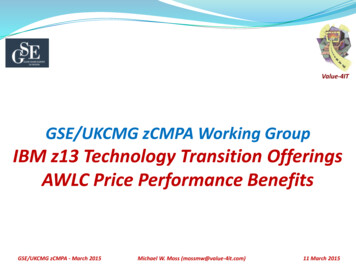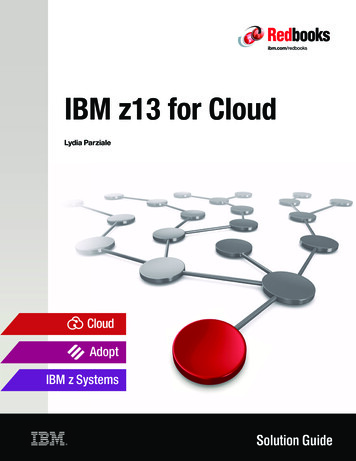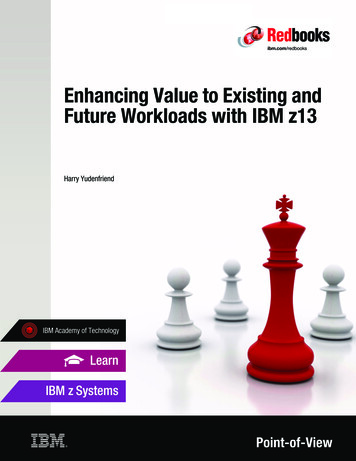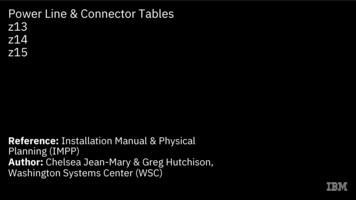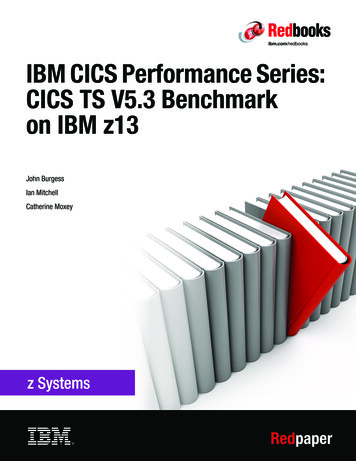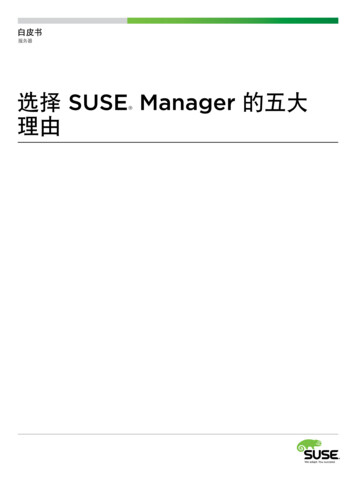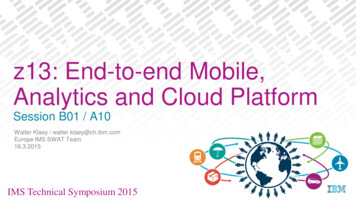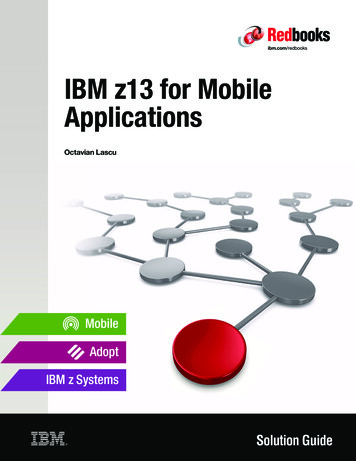
Transcription
IBM z13 for MobileApplicationsOctavian LascuMobileAdoptIBM z SystemsSolution Guide
IBM z13 for Mobile ApplicationsIBM Redbooks Solution GuideIn today’s mobile era, over 10 billion devices are accessing information. Enterprises are challenged withintegrating new mobile services with existing organizational processes, without sacrificing the client’sexperience. Approximately 70% of all enterprise transactions involve IBM z Systems . This IBMRedbooks Solution Guide describes how the new IBM z13 with its enhanced data processingcapabilities can play an important role by providing the secure and stable base that you need to extendyour existing enterprise data and transactions to mobile users. Figure 1 depicts a typical environmentwhere access to applications and interaction with the systems is achieved from mobile devices.Figure 1 Systems of engagement (SOE) for mobile applicationsIBM z Systems provide you with enterprise mobility solutions that can scale to handle the huge number ofoften unpredictable transaction rates and volumes, deliver proven mobile end-to-end integration withreliability, availability, and security, and ensure that your customer data is protected.IBM z13 for Mobile Applications1
Did you know?IBM has the leading platform in systems of record (SOR) with IBM z/OS . IBM provides easilyconsumable mobile access to all the data and transactions in subsystems of z Systems software (IBMDB2 , CICS , IMS , MQ, and others). Customers can create engaging mobile apps today by usingexisting transactions on z Systems. IBM z/OS flagship operating system availability and scalability arecrucial for mobile workloads.IBM is also a key player in systems of engagement (SOEs), Linux on z Systems. Based on its availabilityand scalability, z Systems can handle mobile workloads. In this context, Linux on z Systems provides anexcellent environment for mobile infrastructure.IBM provides the tools to satisfy the lifecycle requirements for mobile application development, including,but not limited to these tools: IBM MobileFirst Studio (formerly IBM Worklight Studio) offers leading tools for mobile appdevelopment, helping to maximize code reuse and accelerate development. IBM MobileFirst Server (formerly IBM Worklight Server) mobile-optimized middleware serves as agateway between applications, back-end system,s and cloud-based services.Business valueBusiness-critical solutions depend on where the source data resides. IBM z Systems deliver a singleworkload-optimized platform for operations (systems of record and systems of engagement, includingmobile applications) and analytics by integrating and managing real-time, historical, and predictive viewsof data.Keeping applications and data as close to each other and as secure as possible is a top priority foroutperforming organizations, and this requires tight integration with operational data. When data resideson disparate and distant servers, several problems might be encountered: Significant effort is spent for moving data, resulting in veracity and security issues.Complicated, bifurcated infrastructure requires multiple skill types.No single point of management.Business continuity concerns.Infrastructure matters for mobile applications. The IBM z System platform’s scalability, security, andresilience can enhance critical mobile applications. The enterprise security capabilities of z Systems canhelp you simplify and improve a complex set of operational security processes. IBM z Systems aredesigned for the highest level of security for commercial grade platforms.The main benefits of implementing mobile apps with IBM MobileFirst Platform on z Systems are asfollows: Easy-to-consume APIs from CICS, DB2, and IMS allow you to leverage your investment in z/OStransactions to quickly add a mobile channel. z/OS enables massive and simple scalability in a single footprint, to handle the workload of millions ofdevices and sensors. IBM MobileFirst Platform security integrates with z/OS security providing end-to-end security and dataprivacy for mobile applications. z/OS Workload Management ensures your crucial applications remain responsive during sharpspikes in demand.IBM z13 for Mobile Applications2
Low-latency I/O. Mobile usage patterns favor short, read-only data requests (users check accountbalances), so fast access to operational data, with low latency, is key. The mainframe offersexceptional I/O with dedicated hardware I/O processors, reducing latency, which increases mobileapp response times. Business resiliency for critical mobile applications.In addition, the following features benefit the development and running of mobile applications on z13: Simultaneous multithreading (SMT): Integrated Facility for Linux (IFL) processors and zIIPs withsoftware support Single-instruction, multiple-data (SIMD): Accelerating computation for analytics Large memory: Providing faster response time to Java and DB2 based applications (in general, anyapplications that can exploit large amount of in-memory data) High-performance communications (network and I/O): Shared Memory Communications over RDMA(SMC-R), IBM FICON Express16S, and so onSolution overviewA typical mobile application environment deployed on z Systems is shown in Figure 2.Figure 2 Mobile environment deployed on IBM z SystemsThe Mobile Middle Tier adds the following components, which are not present in typical web applications: Mobile Device Access Interfaces : Mobile devices can interact with the Mobile Middle Tier (runtimeservers) using open source protocol standards for mobile devices like Java Script Object Notation(JSON) or MQTT. The interfaces supported by the middle tier server qualify it for universality andflexibility.IBM z13 for Mobile Applications3
Mobile Application Management (MAM): The ability to manage multiple applications with respect toversions, device specifics, and operating systems Mobile Device Management (MDM): Management of device level security, access, policies.MDM is responsible to support multiple mobile devices and deliver an ease-of-use management fornew devices and the process to keep existing ones current with the push notification Mobile Services Management (MSM): Various mechanisms to help control and manage mobile appsregardless of their type and OS, as in these examples:oooo Application versions to block faulty or out-of-date versions and seamlessly direct people to the(enterprise) app storeAuthentication and access controlPush Services ManagementUsage reports and analyticsMobile Operational Support : Mobile applications behave differently from traditional applications, havea much shorter life cycle management and change behavior, are more dynamic, and must respondvery fast to customer requirements.The behavior of the Mobile Server must be monitored and (automatic) actions must be taken to avoidunplanned outages. Integration Interfaces : The interfaces to access and interact with data services and transactionalservices enable an integration of back-end systems such as transactional environments with CICSand data services from different databases and platforms.Mobile topology choices can be classified as follows: Browser access : Applications are the same as mobile websites; they are coded in HTML and all theirinteraction is driven by an application server or web server.oooo Hybrid applications : Combine both web and native application programming types. They containnatively coded features to interact with the mobile device, but may primarily interact with applicationservers in SOEs.ooo Written in HTML5, JavaScript and CSS3.Quick and cheap to develop,Less powerful;Browser accessUser arguments web code with native language for unique needsMaximizing user experience;DownloadableNative applications: Are coded in programming languages that run directly on mobile devices. Theyinteract primarily with APIs provided by SORs, but may also run code on application servers in SOEs.oooooPlatform-specificRequires unique expertiseCostly and long development cycleCan deliver higher user experienceDownloadableMobile application can be deployed with or without these components: An application server (IBM WebSphere Application Server)A portalIBM MobileFirst PlatformIBM DataPowerIBM z13 for Mobile Applications4
Solution architectureThe architecture of an IBM MobileFirst Server solution on z Systems is shown in Figure 3.Figure 3 IBM MobileFirst Platform Server deployed on a z SystemThe application on the mobile device contains functions for authentication, a secured container for locallystored data, and a small component to securely connect to the IBM MobileFirst Server. When a mobilerequest reaches MobileFirst Server, further fine-grained security decisions can be incorporated into theapplication logic. After the correct access is granted, the application logic in MobileFirst Server theninteracts with back-end services and data by using the MobileFirst adapters in securely configured zSystems connections. For high performance requirements, MobileFirst can run protocol switchingbetween the requester and back-end service.The flexibility of MobileFirst integration functions enables existing web services on z/OS to be integratedinto mobile applications. A Mobile Feature Pack in CICS enables the communication by using thelightweight JSON protocol.For highly scalable and reliable mobile solutions, z Systems can deliver the best platform to host theseenvironments, and with the MobileFirst Application Center, you can build an enterprise app store formobile apps.IBM MobileFirst Platform can create native, web, or hybrid applications. The MobileFirst Platform HTTPadapter is used to invoke web services (SOAP over HTTP) or RESTful services (JSON over HTTP). Formore information about MobileFirst adapters, see the IBM Knowledge Center:http://ibm.co/1FMqEDSIBM z13 for Mobile Applications5
WebSphere Message Broker users can use “patterns” in the WebSphere Message Broker graphicalinterface to create MobileFirst Platform adapters to send messages to SAP, CICS, and IMS, DB2, Siebel,PeopleSoft (and other business applications). The patterns are deployed to the WebSphere MessageBroker, and the adapters are imported into MobileFirst Platform to be used by mobile applications.WebSphere Message Broker adapter uses HTTP/JSON to communicate to the WebSphere MessageBroker on z Systems.Note: To access DB2 on z/OS, you still need a DB2 Connect license. That is installed in WebSphereApplication Server with the JDBC driver.Usage scenariosIBM MobileFirst solutions on z Systems expand into a broad range of industries and organizations. Usecases apply to financial institutions, healthcare, education, computer services, retail, and more.Assuming that you need your mobile service to be highly reliable, you must be sure to protect againsthardware failure, loss of a network, issues with the operating system, and the application server thatprovides the mobile service. To provide this service, you typically duplicate each of these componentsand have multiple environments to acquire, operate, and replace after a time. Depending on howimportant your app is, you might duplicate all of these components again throughout another region. Thisredundancy is built into the z Systems platform.An example of an architecture using IBM MobileFirst Platform Server for production is shown in Figure 4.Figure 4 IBM MobileFirst Platform Server topologyIBM z13 for Mobile Applications6
In production, MobileFirst Platform web archive (WAR) files (projects) are merged to reduce theproliferation of MobileFirst Platform consoles. Each MobileFirst Platform server (project) has its ownconsole. Administrators merge the security and other configurations in the projects into a single WAR file,which becomes a single MobileFirst Platform server. (This is done primarily because each MobileFirstPlatform server has its own console, and administrators want to have the fewest number of MobileFirstPlatform consoles.) Applications can then be deployed to that MobileFirst Platform server. Those appsoriginated as the separate WAR files the administrator merged.Note: A MobileFirst Platform Project (in development) a WAR a MobileFirst Platform server.The implementation of a mobile solution on z Systems can provide substantial advantages if you consideran implementation designed for high availability. This capability is because of the share-everythingconcepts in the design of the z Systems technology, which allows the sharing of processors and networkchannels, and in case of a failover, the switch to a second logical partition, without doubling the resourcesor machine capacity.Figure 5 shows the implementation of a highly available mobile environment on the z Systems platformwith an IBM DataPower secure gateway (which is positioned in front of the mobile environment), sharedcapacity, and access to a transactional z/OS environment by using the z System internal networkcapability.Figure 5 IBM MobileFirst Platform Server topology for productionIntegrationThe solution integrates well with IBM technologies and transactional and information services by usingIBM MobileFirst adapters for the following items: HTTPJSONIBM WebSphere MQMQTTSOADB2IBM z13 for Mobile Applications7
IMSCICS through HTTP, JSON, and WebSphere MQSAPIBM MobileFirst products: IBM MobileFirst Studio is for mobile app development. IBM MobileFirst Server is mobile-optimized middleware that serves as a gateway betweenapplications, back-end systems and cloud-based services. IBM MobileFirst Device Runtime Components offer runtime client application program interfaces (API)designed to enhance security, governance and usability. IBM MobileFirst Application Center enables you to set up an enterprise app store that manages thedistribution of production-ready mobile apps. IBM MobileFirst Console is an administrative graphical interface, providing real-time operationalanalytics for the server, adapters, and applications and push services to help you manage, monitor,and instrument mobile apps. IBM WebSphere Application Server for Linux on z Systems. IBM CICS, DB2.For details, see the following web ty/Ordering informationThis solution guide introduced a conceptual approach to building a MobileFirst deployment strategy withIBM z System at the core of the solution. This solution encompasses too many products and solutions tobe listed here for ordering. To find individual product solution details, see the general IBM OfferingInformation page (announcement letters and sales manuals) at the following quest locale enYou may also contact your IBM representative for ordering information.Related informationFor more information, see the following documents: System z in a Mobile World, dp5088.html?Open IBM Offering Information page (announcement letters and sales equest locale enOn this page, enter MobileFirst, select the information type, and then click Search. On the nextpage, narrow your search results by information type, geography and language.IBM z13 for Mobile Applications8
NoticesThis information was developed for products and services offered in the U.S.A.IBM may not offer the products, services, or features discussed in this document in other countries. Consult your localIBM representative for information on the products and services currently available in your area. Any reference to anIBM product, program, or service is not intended to state or imply that only that IBM product, program, or service maybe used. Any functionally equivalent product, program, or service that does not infringe any IBM intellectual propertyright may be used instead. However, it is the user's responsibility to evaluate and verify the operation of any non-IBMproduct, program, or service. IBM may have patents or pending patent applications covering subject matter describedin this document. The furnishing of this document does not give you any license to these patents. You can sendlicense inquiries, in writing, to:IBM Director of Licensing, IBM Corporation, North Castle Drive, Armonk, NY 10504-1785 U.S.A.The following paragraph does not apply to the United Kingdom or any other country where such provisions areinconsistent with local law : INTERNATIONAL BUSINESS MACHINES CORPORATION PROVIDES THISPUBLICATION "AS IS" WITHOUT WARRANTY OF ANY KIND, EITHER EXPRESS OR IMPLIED, INCLUDING, BUTNOT LIMITED TO, THE IMPLIED WARRANTIES OF NON-INFRINGEMENT, MERCHANTABILITY OR FITNESSFOR A PARTICULAR PURPOSE. Some states do not allow disclaimer of express or implied warranties in certaintransactions, therefore, this statement may not apply to you. This information could include technical inaccuracies ortypographical errors. Changes are periodically made to the information herein; these changes will be incorporated innew editions of the publication. IBM may make improvements and/or changes in the product(s) and/or the program(s)described in this publication at any time without notice.Any references in this information to non-IBM Web sites are provided for convenience only and do not in any mannerserve as an endorsement of those Web sites. The materials at those Web sites are not part of the materials for thisIBM product and use of those Web sites is at your own risk.IBM may use or distribute any of the information yousupply in any way it believes appropriate without incurring any obligation to you. Information concerning non-IBMproducts was obtained from the suppliers of those products, their published announcements or other publicly availablesources. IBM has not tested those products and cannot confirm the accuracy of performance, compatibility or anyother claims related to non-IBM products. Questions on the capabilities of non-IBM products should be addressed tothe suppliers of those products. This information contains examples of data and reports used in daily businessoperations. To illustrate them as completely as possible, the examples include the names of individuals, companies,brands, and products. All of these names are fictitious and any similarity to the names and addresses used by anactual business enterprise is entirely coincidental.Any performance data contained herein was determined in a controlled environment. Therefore, the results obtainedin other operating environments may vary significantly. Some measurements may have been made ondevelopment-level systems and there is no guarantee that these measurements will be the same on generallyavailable systems. Furthermore, some measurement may have been estimated through extrapolation. Actual resultsmay vary. Users of this document should verify the applicable data for their specific environment.COPYRIGHT LICENSE:This information contains sample application programs in source language, which illustrate programming techniqueson various operating platforms. You may copy, modify, and distribute these sample programs in any form withoutpayment to IBM, for the purposes of developing, using, marketing or distributing application programs conforming tothe application programming interface for the operating platform for which the sample programs are written. Theseexamples have not been thoroughly tested under all conditions. IBM, therefore, cannot guarantee or imply reliability,serviceability, or function of these programs. Copyright International Business Machines Corporation 2015. All rights reserved .Note to U.S. Government Users Restricted Rights -- Use, duplication or disclosure restricted byGSA ADP Schedule Contract with IBM Corp.IBM z13 for Mobile Applications9
This document was created or updated on January 13, 2015.Send us your comments in one of the following ways:Use the online Contact us review form found at:ibm.com/redbooks Send your comments in an e-mail to:redbooks@us.ibm.com Mail your comments to:IBM Corporation, International Technical Support OrganizationDept. HYTD Mail Station P0992455 South RoadPoughkeepsie, NY 12601-5400 U.S.A. This document is available online at l .TrademarksIBM, the IBM logo, and ibm.com are trademarks or registered trademarks of International BusinessMachines Corporation in the United States, other countries, or both. These and other IBM trademarkedterms are marked on their first occurrence in this information with the appropriate symbol ( or ),indicating US registered or common law trademarks owned by IBM at the time this information waspublished. Such trademarks may also be registered or common law trademarks in other countries. Acurrent list of IBM trademarks is available on the Web at http://www.ibm.com/legal/copytrade.shtmlThe following terms are trademarks of the International Business Machines Corporation in the UnitedStates, other countries, or both:CICS DataPower DB2 DB2 Connect FICON IBM IMS Redbooks Redbooks (logo) System z WebSphere Worklight z13 z/OS z Systems The following terms are trademarks of other companies:Linux is a trademark of Linus Torvalds in the United States, other countries, or both.Java, and all Java-based trademarks and logos are trademarks or registered trademarks of Oracle and/orits affiliates.Other company, product, or service names may be trademarks or service marks of others.IBM z13 for Mobile Applications10
IBM z13 for Mobile Applications 3 Low-latency I/O. Mobile usage patterns favor short, read-only data requests (users check account balances), so fast access to operational data, with low latency, is key. The mainframe offers exceptional I/O with dedicated hardware I/O processors, reducing latency, which increases mobile
